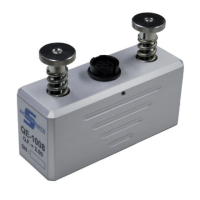2 QE-1008_Instruction Manual_02-2014_ENG
2
1. Description
1.1 Introduction
The magnet-strain sensors type QE-1008 are latest generation extensometers with two integrated super magnets to
measure the bending compensated tie-bar elongation and/or load ( load: if two extensometers are used on one tie bar).
The improved design does not only make the sensor shorter, but also increases the absolute accuracy. Therefore all the
sensors are interchangeable.
This makes the measurement and check of the following parameters even easier:
Tie bar load distribution
Clamping force measurement
Elongation- and strain measurement on any flat surface (e.g. mould platen)
Advantages of this system:
Very high accuracy: <1% absolute (like bonded strain gauges)
Safe against machine vibration and shock (like the strain rings)
One system for all tie bar diameters
Measures also reliable on flat surfaces
2 sensors for bending compensated measurements
Quick & easy mounting
Digital monitor with direct Force/Load display (kN/t)
Optional software available (according to ISO9001/Euromap)
Comes in carrying case with 2, 4 or 8 extensometers
Light and handy case
One system for the high tech molding shop.
1.2 Technology
The extensometer QE-1008 is based on pressed-on strain gauges. This successful technology is used in many products
for the molding industry.
The pressed-on strain-gauge is placed under a stainless steel foil between the two magnets.
The strong magnets press the strain gauge that strong onto the surface of the tie bar that friction occurs between the
strain gauge, the foil and the tie bar.
This friction replaces the usually used strain gauge adhesive that means easier application with the same results, but
without bonding.
Finally this technology allows highly accurate tie-bar elongation-measurement with fast and reliable mounting.
The sensors are basically magnet mounted and reusable strain gauges which measure strain on cylinders or flat surfaces.

